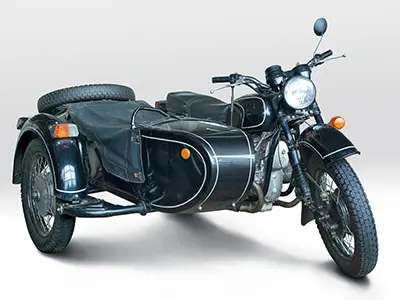
The Kiev Motorcycle Plant, whose history began exactly eighty years ago with a decree of the Council of People's Commissars, became not just an industrial enterprise, but a true symbol of an entire era in domestic engineering. The decision to establish it on the basis of Armoured Repair Plant No. 8, which traces its history back to 1932 from the armoured vehicle workshops of the Kiev Military District, marked the transition from military to peaceful production, although the military heritage continued to determine the specifics of the plant for a long time. After the end of the Great Patriotic War, equipment from the German Wanderer factory in Chemnitz, which was located in the Soviet occupation zone, was brought to Kiev to organise the production of motor vehicles, which made it possible to assemble the first ten motorcycles from machine kits in December 1945 and by September 1946, mass production was established.
The plant's first product was the K1B Kiyanan motorbike, assembled from German components, including Fichtel & Sachs engines from Schweinfurt, as Wanderer itself did not manufacture power units for its vehicles. These single-cylinder engines with a displacement of 98 cubic centimetres and a power output of 2.3 horsepower were installed on Kiev motorcycles until 1949, when the plant began producing its own engines. The design of the Kiyanan was based on the German prototype, with a two-speed gearbox shifted by a small lever on the right side of the fuel tank. The vehicle weighed 65 kilograms and had a maximum speed of 50 kilometres per hour with a fuel consumption of 2.25 litres per 100 kilometres. By 1953, when production of the K1B ceased, around 30,000 of these vehicles had been produced, becoming the first truly mass-produced two-wheeled transport in the post-war Soviet Union.
In parallel with the production of motorcycles, the factory mastered the production of three-wheeled K1V motorised tricycles designed for people with disabilities who urgently needed an affordable and practical means of transport. This model used components and assemblies from the K1B, but with significant modifications, including a forced air-cooled engine enclosed by a cowling and a specific control system operated only by hand using a long steering lever and a separate engine start lever. The first motorised sidecars were assembled in December 1946, and their serial production began the following year. By 1953, a total of about 19,000 K1V units had been produced, making a significant contribution to the social adaptation of war and labour invalids.
A new stage in the history of the plant was the transition to the production of heavy motorcycles with sidecars, which began in 1951 with the M-72 model, essentially a copy of the pre-war BMW R71, with a 750 cc engine and 22 horsepower. However, in 1957, production began on the more advanced K-750 motorcycles with 26 horsepower, and ten years later, the K-650 Dnepr motorcycle with a 32 horsepower engine appeared. In the 1970s, improved MT series motorcycles with 32 and 36 horsepower were produced, and in the 1980s, the Dnepr-11 and its variant with a sidecar drive wheel, the Dnepr-16, were produced. which were hugely popular both in the Soviet Union and abroad. In its heyday, the factory produced tens of thousands of motorcycles annually, exporting them to eighty countries on five continents. However, in the 1990s, production began to decline rapidly, falling to a few hundred per year by the early 2000s and finally ceasing in 2008, with the exception of a few individual orders. Throughout its history, the Kiev Motorcycle Factory produced about three million motorcycles, leaving a bright mark in the history of domestic transport.

